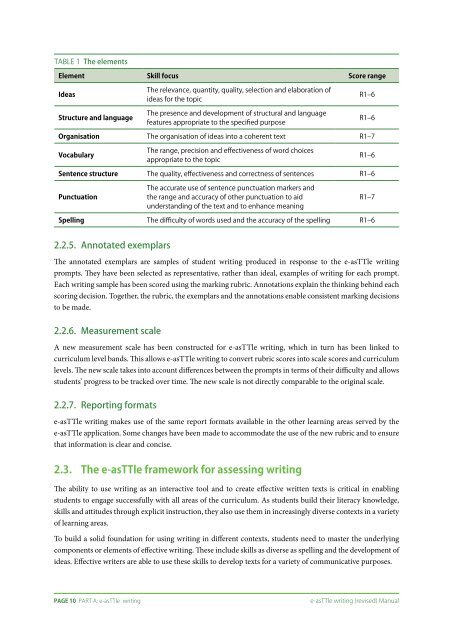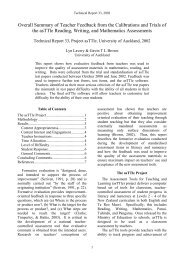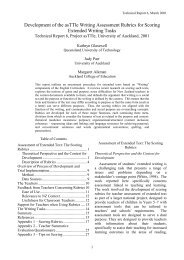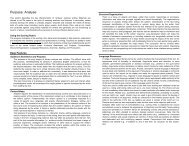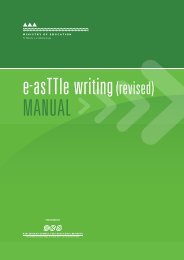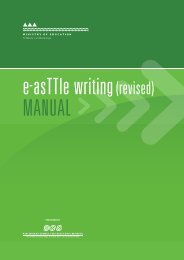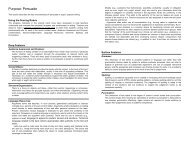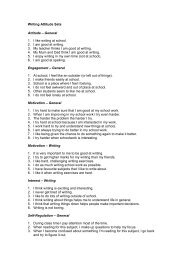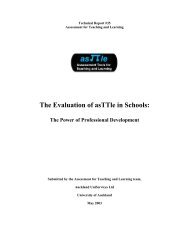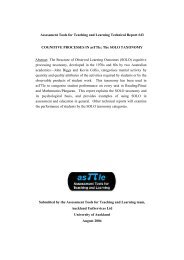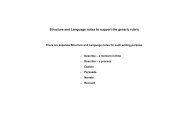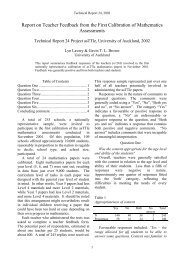Table 1 The elementsElement Skill focus Score rangeIdeasStructure and languageThe relevance, quantity, quality, selection and elaboration ofideas for the topicThe presence and development of structural and languagefeatures appropriate to the specified purposeR1–6R1–6Organisation The organisation of ideas into a coherent text R1–7VocabularyThe range, precision and effectiveness of word choicesappropriate to the topicR1–6Sentence structure The quality, effectiveness and correctness of sentences R1–6PunctuationThe accurate use of sentence punctuation markers andthe range and accuracy of other punctuation to aidunderstanding of the text and to enhance meaningR1–7Spelling The difficulty of words used and the accuracy of the spelling R1–62.2.5.Annotated exemplarsThe annotated exemplars are samples of student <strong>writing</strong> produced in response to the e-<strong>asTTle</strong> <strong>writing</strong>prompts. They have been selected as representative, rather than ideal, examples of <strong>writing</strong> for each prompt.Each <strong>writing</strong> sample has been scored using the marking rubric. Annotations explain the thinking behind eachscoring decision. Together, the rubric, the exemplars and the annotations enable consistent marking decisionsto be made.2.2.6.Measurement scaleA new measurement scale has been constructed for e-<strong>asTTle</strong> <strong>writing</strong>, which in turn has been linked tocurriculum level bands. This allows e-<strong>asTTle</strong> <strong>writing</strong> to convert rubric scores into scale scores and curriculumlevels. The new scale takes into account differences between the prompts in terms of their difficulty and allowsstudents’ progress to be tracked over time. The new scale is not directly comparable to the original scale.2.2.7.Reporting formatse-<strong>asTTle</strong> <strong>writing</strong> makes use of the same report formats available in the other learning areas served by thee-<strong>asTTle</strong> application. Some changes have been made to accommodate the use of the new rubric and to ensurethat information is clear and concise.2.3.The e-<strong>asTTle</strong> framework for assessing <strong>writing</strong>The ability to use <strong>writing</strong> as an interactive tool and to create effective written texts is critical in enablingstudents to engage successfully with all areas of the curriculum. As students build their literacy knowledge,skills and attitudes through explicit instruction, they also use them in increasingly diverse contexts in a varietyof learning areas.To build a solid foundation for using <strong>writing</strong> in different contexts, students need to master the underlyingcomponents or elements of effective <strong>writing</strong>. These include skills as diverse as spelling and the development ofideas. Effective writers are able to use these skills to develop texts for a variety of communicative purposes.Page 10 Part A: e-<strong>asTTle</strong> <strong>writing</strong>e-<strong>asTTle</strong> <strong>writing</strong> (<strong>revised</strong>) <strong>Manual</strong>
The e-<strong>asTTle</strong> <strong>writing</strong> tool enables teachers to assess students’ level of achievement in <strong>writing</strong> to communicate,through analysis of their skill development in a number of important elements of <strong>writing</strong>. Students producea piece of <strong>writing</strong> in response to a teacher-selected e-<strong>asTTle</strong> <strong>writing</strong> prompt. The prompts are open-ended<strong>writing</strong> activities that require students to communicate to a general adult audience. They are based onaccessible topics, and cover five main communicative purposes for <strong>writing</strong>: to describe, explain, persuade,narrate and recount. These purposes are core to many of the <strong>writing</strong> demands of the learning areas of the NewZealand curriculum.The student’s <strong>writing</strong> is then scored using an analytic, criterion-referenced marking rubric. The rubric focuseson seven elements of <strong>writing</strong> that can be assessed through analysis of the written text: ideas, structure andlanguage, organisation, vocabulary, sentence structure, punctuation and spelling. Mastery of these distinctbut interrelated elements provides students with many of the tools they need to meet the demands of complex<strong>writing</strong> tasks across the curriculum. Each element is divided into an ordered set of skill categories, representinga continuum of development. The student’s <strong>writing</strong> is scored element by element. Scores for each element areentered into the tool to produce an overall score, which is located on a measurement scale.The e-<strong>asTTle</strong> framework allows teachers to identify students’ particular strengths and areas for furtherdevelopment, by focusing on knowledge and skill levels within each element of <strong>writing</strong>. Students’ scores arelikely to vary across the elements, producing rich, fine-grained diagnostic information to inform decisionsabout individual and group learning. Information from the tool can also enable teachers to make judgmentsabout their students’ progress over time, and to plan next learning goals. In addition, the e-<strong>asTTle</strong> <strong>writing</strong>tool can make a significant contribution to the wide range of evidence supporting an overall teacher judgmentabout each student’s performance in relation to national standards.2.3.1.Developing the prompts, marking rubric, and annotated exemplarsThirty prompts were drafted and piloted at a small number of diverse schools and year levels to gatherinformation on the suitability of the prompts for the tool. Twenty-five prompts were selected to go on tothe next stage of development. The student <strong>writing</strong> scripts produced from those prompts were then used todevelop the rubric and the annotated exemplars.The process of developing the marking rubric involved researchers first making tentative decisions aboutpossible elements and scoring ranges for the rubric. These decisions were based on knowledge of general<strong>writing</strong> research, experience in developing similar <strong>writing</strong> tools, advice from reference group members, andguidance provided by curriculum documents. Scripts were then grouped according to purpose and prompt.Researchers worked systematically, prompt by prompt, to rank the scripts from weakest to strongest andto enter brief descriptions of the <strong>writing</strong> features they saw in the scripts to the marking rubric. Over time,patterns of features emerged. For example, it was found that the sentences in the lowest ranked scriptsconsisted of fragments and phrases, and often had missing words, and that the next stage consisted of shortsimple, compound, and basic complex sentences.Twenty-one prompts were selected to be trialled, and the draft rubric was used to mark the approximatelyfive thousand scripts produced from the trial. The marking process made significant contributions to therefinement of the rubric and also produced scripts that became important additions to the pool of annotatedexemplars.The process began in mid 2011 and was completed by the end of that year. The 20 prompts finally selected, therubric, and the annotated exemplars are the result of a detailed and rigorous process that involved fine-tuningthe materials throughout.Page 11 Part A: e-<strong>asTTle</strong> <strong>writing</strong>e-<strong>asTTle</strong> <strong>writing</strong> (<strong>revised</strong>) <strong>Manual</strong>


